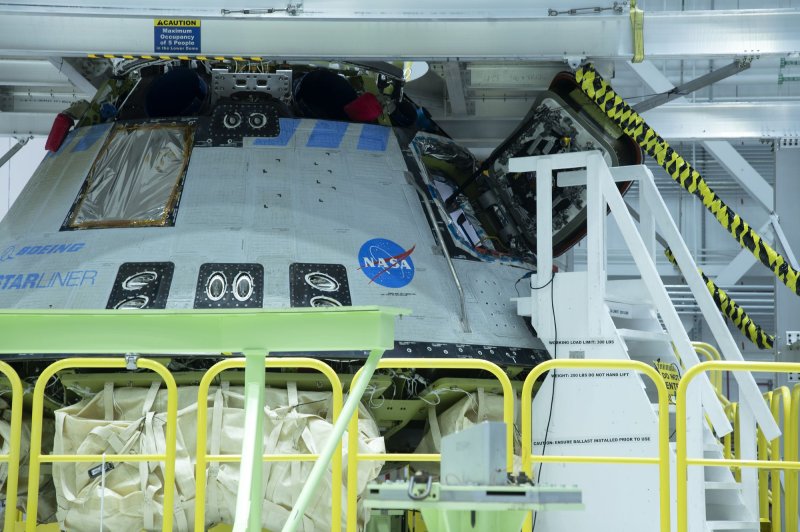The Boeing Starliner spacecraft sits in its processing facility at the Kennedy Space Center, Fla., on Jan. 15 to be refurbished after its ill-fated flight. File Photo by Joe Marino/UPI |
License Photo
Feb. 7 (UPI) -- Two "critical" software defects found after an unpiloted test flight of the Boeing Starliner capsule in December could have caused destruction of the vehicle had they not been corrected by ground controllers, NASA said Friday.
"The two software issues are likely are only symptoms, not the root problem," Douglas Loverro, associate administrator of NASA's Human Exploration and Operations Mission Directorate, said during a briefing at Kennedy Space Center in Florida.
NASA hopes Boeing's crew capsule eventually will ferry astronauts to and from the International Space Station, but during its December test flight, Starliner suffered multiple software glitches and failed to dock at the space station as planned.
In January, NASA and Boeing convened an independent review team to investigate the Starliner's shortcomings. The review is ongoing, but this week the review team offered preliminary findings, as well as an initial list of corrective actions.
Until Friday's announcement and press briefing, Boeing and NASA had confirmed only one software error, which caused the capsule to miss a planned docking with International Space Station because Starliner did not reach the planned orbital height.
"After finding the first software glitch, we went looking for similar problems, and we found one," said Jim Chilton, senior vice president of Boeing's Space and Launch Division. "We found it because we went looking."
The joint NASA-Boeing investigation team found that ground intervention prevented loss of the vehicle in both cases.
"While this anomaly was corrected in flight, if it had gone uncorrected, it would have led to erroneous thruster firings and uncontrolled motion during [service module] separation from deorbit, with the potential for a catastrophic spacecraft failure," said Paul Hill, a member of the NASA Aerospace Safety Advisory Panel that is examining problems with the mission.
Hill is the former director of Mission Operations at NASA's Lyndon B. Johnson's Space Center in Houston and a former flight director for the space shuttle and International Space Station.
The additional software error places into further doubt that Starliner will be permitted to carry astronauts to the space station without another test flight. SpaceX, which has developed a Crew Dragon capsule, is expected to carry two NASA astronauts to the space station as early as this spring.
The investigation also revealed issues with the vessel's Intermittent space-to-ground communication system, which impeded the ability of Boeing's engineers and flight managers to command and control the spacecraft -- and investigators already have provided 11 top-priority corrective actions to the Boeing team.
During Friday's press briefing, NASA and Boeing officials said the software glitches were the result of breakdowns in both the design and code phase and the test and verification phase.
The fixes will require "systemic corrective actions," NASA said in a statement ahead of the briefing, with Loverro saying that "numerous process escapes" existed during which both NASA and Boeing could have uncovered the defects.
NASA said it expects to have the know the root causes of the issues and provide a full set of corrective actions for Starliner by the end of February.
"We want to assure that these necessary steps are completely understood prior to determining the plan for future flights," NASA said. "Separately from the anomaly investigation, NASA also is still reviewing the data collected from the test flight to help determine the future plan."
Shortly after its liftoff from Kennedy Space Center in Florida atop a United Launch Alliance Atlas 5 rocket -- on a mission to put the commercial capsule to the test -- the spacecraft immediately deviated from its flight plan, firing thrusters unexpectedly, reorienting itself and using too much fuel, which prevented rendezvous and docking with the space station.
Engineers on the ground regained control of the spacecraft and placed it in a safe orbit, albeit too low to rendezvous with the space station. Mission controllers carried out as many other tests as possible and then brought Starliner back for a landing in New Mexico.
The capsule, which for the most part was not damaged in re-entry, is being refurbished at Kennedy Space Center.
"We going to continue our ground software tests and we're going to test until we get this right," said John Mulholland, vice president and program manager or Boeing's Starliner program.















